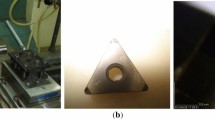Abstract
Grinding is a machining process that provides a combination of good surface finishing and tight dimensional tolerances on a machined component. Owing to these characteristics, it is employed in the finishing process of hardened parts, such as high-speed steel (HSS) cutting tools (principally drills and taps). Despite the various benefits, the specific energy in grinding is very high, resulting in high heat generated in the wheel–workpiece interface that could lead to thermal damages. To avoid such problems, aiming to maximize productivity and preserve the integrity of the machined component, a cutting fluid and cutting parameters must be properly selected. However, since the process dynamics is particular for each grinding process, especially in complex geometries, specific studies in real manufacturing conditions are required to understand the phenomena and minimize surface damages. In this context, this work aims to evaluate the surface integrity of M3 HSS cutting taps after they have been ground at various cutting conditions. Machining tests were performed in situ under controlled and variable wheel speed, depth of cut, and workpiece speed conditions. Machined surface images and microhardness below the surface were the output variables investigated. Results showed that, on average, the thickness of the affected surface layer was about 70% lower after machining at the lowest workpiece speed used. The correlation between grinding removal rates and thermal damage was also discussed.
Similar content being viewed by others
References
Schumann S, Siebrecht T, Kersting P, Biermann D, Holtermann R, Menzel A (2015) Determination of the thermal load distribution in internal traverse grinding using a geometric-kinematic simulation. Procedia CIRP 31:322–327. https://doi.org/10.1016/j.procir.2015.03.020
Barrenetxea D, Alvarez J, Marquinez JI, Sanchez JA (2016) Grinding with controlled kinematics and chip removal. CIRP Ann. - Manuf. Technol. 65:341–344. https://doi.org/10.1016/j.cirp.2016.04.097
Hou ZB, Komanduri R (2004) On the mechanics of the grinding process, part II—thermal analysis of fine grinding. Int J Mach Tools Manuf 44:247–270. https://doi.org/10.1016/j.ijmachtools.2003.09.008
Ren L, Wang S, Yi L, Sun S (2016) An accurate method for five-axis flute grinding in cylindrical end-mills using standard 1V1/1A1 grinding wheels. Precis Eng 43:387–394. https://doi.org/10.1016/j.precisioneng.2015.09.002
Drazumeric R, Badger J, Krajnik P (2014) Geometric, kinematical and thermal analyses of non-round cylindrical grinding. J Mater Process Technol 214:818–827. https://doi.org/10.1016/j.jmatprotec.2013.12.007
M.J. Jackson, J.P. Davim, Machining with abrasives, 2011. doi:https://doi.org/10.1007/978-1-4419-7302-3.
J.P. Davim, Surface integrity in machining, 2010. doi:https://doi.org/10.1007/978-1-84882-874-2.
W.B. Rowe, Principles of modern grinding technology: second edition, 2013. doi:https://doi.org/10.1016/C2013-0-06952-6.
I.D. Marinescu, W.B. Rowe, B. Dimitrov, H. Ohmori, I.D. Marinescu, W.B. Rowe, B. Dimitrov, H. Ohmori, 6—Thermal design of processes, in: Tribol. Abras. Mach. Process., 2013: pp. 137–184. doi:https://doi.org/10.1016/B978-1-4377-3467-6.00006-9.
Malkin S, Anderson RB (1974) Thermal aspects of grinding: part 1—energy partition. J Eng Ind 96:1177. https://doi.org/10.1115/1.3438492
Lavine AS, Jen T-C (1991) Coupled heat transfer to workpiece, wheel, and fluid in grinding, and the occurrence of workpiece burn. Int J Heat Mass Transf 34:983–992. https://doi.org/10.1016/0017-9310(91)90009-4
Shaw MC (1996) Energy conversion in cutting and grinding*. CIRP Ann. - Manuf. Technol. 45:101–104. https://doi.org/10.1016/S0007-8506(07)63025-X
Mayer JE, Price AH, Purushothaman GK, Dhayalan AK, Pepi MS (2002) Specific grinding energy causing thermal damage in helicopter gear steel. J Manuf Process 4:142–147. https://doi.org/10.1016/S1526-6125(02)70140-0
Zarudi I, Zhang LC (2002) A revisit to some wheel–workpiece interaction problems in surface grinding. Int J Mach Tools Manuf 42:905–913. https://doi.org/10.1016/S0890-6955(02)00024-X
Ren YH, Zhang B, Zhou ZX (2009) Specific energy in grinding of tungsten carbides of various grain sizes. CIRP Ann. - Manuf. Technol. 58:299–302. https://doi.org/10.1016/j.cirp.2009.03.026
Malkin S, Guo C (2007) Thermal analysis of grinding. CIRP Ann. - Manuf. Technol. 56:760–782. https://doi.org/10.1016/j.cirp.2007.10.005
Aurich JC, Sudermann H, Bil H (2005) Characterisation of burr formation in grinding and prospects for modelling. CIRP Ann - Manuf Technol 54:313–316. https://doi.org/10.1016/S0007-8506(07)60111-5
M.C. Avila, D.A. Dornfeld, On the face milling burr formation mechanisms and minimization strategies at high tool engagement, in: 7th Int. Conf. Deburring Edge Finish., 2004.
S. Malkin, C. Guo, Grinding technology: theory and applications of machining with abrasives, 2nd ed., Industrial press Inc., 2008.
Söderberg S, Hogmark S (1986) Wear mechanisms and tool life of high speed steels related to microstructure. Wear 110:315–329. https://doi.org/10.1016/0043-1648(86)90106-7
Chaus AS, Hudáková M (2009) Wear resistance of high-speed steels and cutting performance of tool related to structural factors. Wear 267:1051–1055. https://doi.org/10.1016/j.wear.2008.12.101
Moore MA (1974) The relationship between the abrasive wear resistance, hardness and microstructure of ferritic materials. Wear 28:59–68. https://doi.org/10.1016/0043-1648(74)90101-X
Arul Saravanapriyan SN, Vijayaraghavan L, Krishnamurthy R (2003) Significance of grinding burn on high speed steel tool performance. J Mater Process Technol 134:166–173. https://doi.org/10.1016/S0924-0136(02)00461-2
Funding
Two of the authors thank the Post-Graduate Program in Mechanical Engineering of the Federal University of Uberlândia, CAPES-Proex, and CNPq for the financial support. One of the authors thanks FAPEMIG for the financial support received through PPM-VII Project, Process No. PPM-00265-13 as well as the CAPES for the financial support given by a PNDP project—post-doctoral scholarship at the Post-Graduate Program of Electrical Engineering of FEB-UNESP-BAURU (2016–2017).
Author information
Authors and Affiliations
Corresponding author
Rights and permissions
About this article
Cite this article
Vendrame, S., da Silva, R.B., Machado, Á.R. et al. Surface integrity assessment of M3 HSS cutting taps after grinding at various machining conditions. Int J Adv Manuf Technol 98, 617–627 (2018). https://doi.org/10.1007/s00170-018-2245-x
Received:
Accepted:
Published:
Issue Date:
DOI: https://doi.org/10.1007/s00170-018-2245-x




